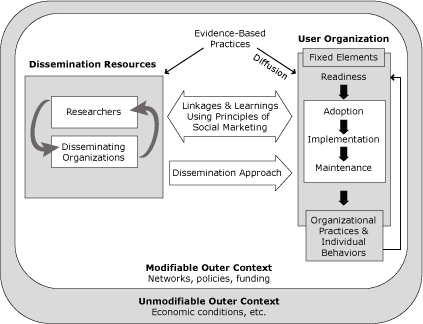Figure.
The dissemination framework shows the resources (researchers and disseminating organizations) affecting a user organization through a dissemination approach developed collaboratively, using social marketing principles. The framework functions in an outer context of modifiable and unmodifiable elements.
| The HPRC dissemination framework has 2 key elements: the resources for disseminating an evidence-based practice, which include collaborating researchers and disseminating organizations, and the user organization that adopts and implements the practice. The dissemination approach is developed by using social marketing principles and requires linking to and learning from the user organization to develop relevant and effective dissemination. The user organization has characteristics that affect its readiness to change. Each characteristic is dependent on the preceding one. These characteristics start with the fixed elements and the readiness to adopt an intervention. Readiness affects the 3 stages of adoption (adoption, implementation, and maintenance). Finally, the implementation of intervention affects the organization's practices and individuals' behaviors, which in turn feeds back into the organization by affecting its fixed elements and readiness to change. The framework also acknowledges that the adoption of an intervention may also occur through passive diffusion. The elements of the framework — the resources, user organization, and dissemination approach — exist in an outer context of modifiable (networks, policies, funding) and unmodifiable (economic conditions, etc.) elements. |
| This framework is based on existing literature on dissemination, including Greenhalgh (5), Wandersman's interactive systems framework (6), the consolidated framework for implementation research (7), and RE-AIM (8), as well as our experience disseminating evidence-based practices. |

